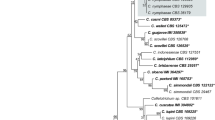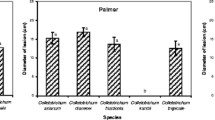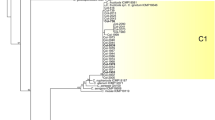Abstract
Katsura-uri is a variety of Japanese pickling melon (Cucumis melo var. conomon) and traditionally cultivated in the Kyoto area in Japan. The thick flesh and crunchy texture of the fruit are excellent for making Japanese pickles. In 2010, dark brown to black anthracnose spots were found on ripening Katsura-uri fruits after harvest. Four fungal strains (T1, K1, K2 and K3) were isolated from lesions on fruits and identified as four Colletotrichum species (C. orbiculare, C. fructicola, C. aenigma and C. chlorophyti) based on phylogenetic analysis. C. orbiculare K3 isolate caused necrotic lesions on Katsura-uri leaves, whereas C. fructicola K1, C. aenigma K2 and C. chlorophyti T1 isolates caused necrotic lesions on Katsura-uri fruits but not on leaves. Inoculation assays to ripe and immature Katsura-uri fruits suggested that C. chlorophyti causes a postharvest disease; necrotic lesions developed only on ripe fruits. This study showed that multiple Colletotrichum species caused anthracnose on Katsura-uri fruits.







Similar content being viewed by others
References
Alkan N, Fluhr R, Sherman A, Prusky D (2008) Role of ammonia secretion and pH modulation on pathogenicity of Colletotrichum coccodes on tomato fruit. Mol Plant Microbe Interact 21:1058–1066
Alkan N, Davydov O, Sagi M, Fluhr R, Prusky D (2009) Ammonium secretion by Colletotrichum coccodes activates host NADPH oxidase activity enhancing host cell death and fungal virulence in tomato fruits. Mol Plant Microbe Interact 22:1484–1491
Bragard C, Baptista P, Chatzivassiliou E, Serio FD, Gonthier P, Miret JAJ, Justesen AF, MacLeod A, Magnusson CS, Milonas P, Navas-Cortes JA, Parnell S, Potting R, Reignault PL, Stefani E, Thulke HH, Werf WVD, Civera AV, Yuen J, Zappalà L, Migheli Q, Vloutoglou I, Czwienczek E, Maiorano A, Streissl Reignault PL (2022) Pest categorisation of Colletotrichum aenigma, C. alienum, C. perseae, C. siamense and C. theobromicola. EFSA J 20:e07529
Cannon PF, Damm U, Johnston PR, Weir BS (2012) Colletotrichum—current status and future directions. Stud Mycol 73:181–213
Carbone I, Kohn LM (1999) A method for designing primer sets for speciation studies in filamentous ascomycetes. Mycologia 91:553–556
Castresana J (2000) Selection of conserved blocks from multiple alignments for their use in phylogenetic analysis. Mol Biol Evol 17:540–552
Cheng YJ, Wu YJ, Lee FW (2022) Impact of storage condition on chemical composition and antifungal activity of pomelo extract against Colletotrichum gloeosporioides and anthracnose in post-harvest mango. Plants 11:2064
Ciofini A, Negrini F, Baroncelli R (2022) Management of post-harvest anthracnose: current approaches and future perspectives. Plants 11:1856
Crous PW, Gams W, Stalpers JA, Robert V, Stegehuis G (2004) MycoBank: an online initiative to launch mycology into the 21st century. Stud Mycol 50:19–22
Dinh SQ, Chongwungse J, Pongam P, Sangchote S (2003) Fruit infection by Colletotrichum gloeosporioides and anthracnose resistance of some mango cultivars in Thailand. Australas Plant Pathol 32:533–538
Droby S, Prusky D, Jacoby B, Goldman A (1987) Induction of anti-fungal resorcinols in flesh of unripe mango fruits and its relation to latent infection by Alternaria alternata. Physiol Mol Plant Pathol 30:285–292
Freeman S, Minz D, Maymon M, Zveibil A (2001) Genetic diversity within Colletotrichum acutatum sensu Simmonds. Phytopathology 91:586–592
Friesen TL, Stukenbrock EH, Liu Z, Meinhardt S, Ling H, Faris JD, Rasmussen JB, Solomon PS, McDonald BA, Oliver RP (2006) Emergence of a new disease as a result of interspecific virulence gene transfer. Nat Genet 38:953–956
Fuentes-Aragón D, Juárez-Vázquez SB, Vargas-Hernández S-R (2018) Colletotrichum fructicola, a member of Colletotrichum gloeosporioides sensu lato, is the causal agent of anthracnose and soft rot in avocado fruits cv. “Hass.” Mycobiology 46:92–100
Gan P, Narusaka M, Tsushima A, Narusaka Y, Takano Y, Shirasu K (2017) Draft genome assembly of Colletotrichum chlorophyti, a pathogen of herbaceous plants. Genome Announc 5:e01733-e1816
Gow NAR, Latge JP, Munro CA (2017) The fungal cell wall: structure, biosynthesis, and function. Microbiol Spectr 5:3
Guo Z, Luo CX, Wu HJ, Peng B, Kang BS, Liu LM, Zhang M, Gu QS (2022) Colletotrichum species associated with anthracnose disease of watermelon (Citrullus lanatus) in China. J Fungi 8:790
Jiang D, Nakamura Y, Park E, Sato K, Shirota K, Suetome N, Kubo Y (2012) New anthracnose disease occurring on Kyoto vegetables-Katsura Cucumis melo. Jpn J Phytopathol 78:197
Kanno H, Moriwaki J (2000) Anthracnose of netted melon (Cucumis melo var. reticulatus Naud.) caused by Colletotrichum orbiculare (Berkeley & Montagne) Arx. Jpn J Phytopathol 66:85–90 (in Japanese with English summary)
Kobiler I, Prusky D, Midland S, Sims JJ, Keen NT (1993) Compartmentation of antifungal compounds in oil cells of avocado fruit mesocarp and its effect on susceptibility to Colletotrichum gloeosporioides. Physiol Mol Plant Pathol 43:319–328
Kong LA, Yang J, Li GT, Qi LL, Zhang YJ, Wang CF, Zhao WS, Xu JR, Peng YL (2012) Different chitin synthase genes are required for various developmental and plant infection processes in the rice blast fungus Magnaporthe oryzae. PLoS Pathog 8:e1002526
Kubo Y, Takano Y (2013) Dynamics of infection-related morphogenesis and pathogenesis in Colletotrichum orbiculare. J Gen Plant Pathol 79:233–242
Letunic I, Bork P (2007) Interactive Tree Of Life (iTOL): an online tool for phylogenetic tree display and annotation. Bioinformatics 23:127–128
Liang X, Wang B, Dong Q, Li L, Rollins JA, Zhang R, Sun G (2018) Pathogenic adaptations of Colletotrichum fungi revealed by genome wide gene family evolutionary analyses. PLoS One 13:e0196303
Lima NB, Marques MW, Michereff SJ (2013) First report of mango anthracnose caused by Colletotrichum karstii in Brazil. Plant Dis 97:1248
Liu Z, Zhang X, Liu X, Fu C, Han X, Yin Y, Ma Z (2016) The chitin synthase FgChs2 and other FgChss co-regulate vegetative development and virulence in F. graminearum. Sci Rep 6:34975
Nakamura Y, Nakayama Y, Ando H, Tanaka A, Matsuo T, Okamoto S, Upham BL, Chang CC, Trosko JE, Park EY, Sato K (2008a) 3-Methylthiopropionic acid ethyl ester, isolated from Katsura-uri (Japanese pickling melon, Cucumis melo var. conomon), enhanced differentiation in human colon cancer cells. J Agric Food Chem 56:2977–2984
Nakamura Y, Matsuo T, Okamoto S, Nishikawa A, Imai T, Park EY, Sato K (2008b) Antimutagenic and anticarcinogenic properties of Kyo-yasai, heirloom vegetables in Kyoto. Genes Environ 30:41–47
Nakamura Y, Watanabe S, Kageyama M, Shirota K, Shirota K, Amano H, Kashimoto T, Matsuo T, Okamoto S, Park EY, Sato K (2010) Antimutagenic; differentiation-inducing; and antioxidative effects of fragrant ingredients in Katsura-uri (Japanese pickling melon; Cucumis melo var. conomon). Mutat Res 703:163–168
Nylander JAA (2004) MrModeltest v2. Program distributed by the author. Evolutionary Biology Centre, Uppsala University, Uppsala
O’Donnell K, Cigelnik E (1997) Two divergent intragenomic rDNA ITS2 types within a monophyletic lineage of the fungus Fusarium are nonorthologous. Mol Phylogenet Evol 7:103–116
Phoulivong S, Lei C, Chen H, McKenzie EHC, Abdelsalam K, Chukeatirote E, Hyde KD (2010) Colletotrichum gloeosporioides is not a common pathogen on tropical fruits. Fungal Divers 44:33–43
Prusky D (1998) Mechanisms of resistance of fruits and vegetables to postharvest diseases. ACIAR Proc 80:19–33
Prusky D, McEvoy JL, Leverentz B, Conway WS (2001) Local modulation of host pH by Colletotrichum species as a mechanism to increase virulence. Mol Plant Microbe Interact 14:1105–1113
Qiu H, Cai G, Luo J, Bhattacharya D, Zhang N (2016) Extensive horizontal gene transfers between plant pathogenic fungi. BMC Biol 14:41
Rampersad SN (2010) First report of anthracnose caused by Colletotrichum gloeosporioides in pumpkin in Trinidad. Plant Dis 94:1062
Ronquist F, Huelsenbeck JP (2003) MrBayes 3: Bayesian phylogenetic inference under mixed models. Bioinformatics 19:1572–1574
Saitoh K, Togashi K, Arie T, Teraoka T (2006) A simple method for a mini-preparation of fungal DNA. J Gen Plant Pathol 72:348–350
Sato T, Moriwaki J, Kaneko S (2015) Anthracnose fungi with curved conidia, Colletotrichum spp. belonging to ribosomal groups 9–13, and their host ranges in Japan. JARQ 49:351–362
Sharma G, Kumar N, Weir BS, Hyde KD, Shenoy BD (2013) The ApMat marker can resolve Colletotrichum species: a case study with Mangifera indica. Fungal Divers 61:117
Stamatakis A (2014) RAxML version 8: a tool for phylogenetic analysis and post-analysis of large phylogenies. Bioinformatics 30:1312–1313
Talhinhas P, Baroncelli R (2021) Colletotrichum species and complexes: geographic distribution, host range and conservation status. Fungal Divers 110:109–198
Tamura K, Stecher G, Kumar S (2021) MEGA11: molecular evolutionary genetics analysis version 11. Mol Biol Evol 38:3022–3027
Templeton MD, Rikkerink EH, Solon SL, Crowhurst RN (1992) Cloning and molecular characterization of the glyceraldehyde-3-phosphate dehydrogenase-encoding gene and cDNA from the plant pathogenic fungus Glomerella cingulate. Gene 122:225–230
Tsushima A, Shirasu K (2022) Genomic resources of Colletotrichum fungi: development and application. J Gen Plant Pathol 88:349–357
Weir BS, Johnston PR, Damm U (2012) The Colletotrichum gloeosporioides species complex. Stud Mycol 73:115–180
Werner S, Sugui JA, Steinberg G, Deising HB (2007) A chitin synthase with a myosin-like motor domain is essential for hyphal growth, appressorium differentiation, and pathogenicity of the maize anthracnose fungus Colletotrichum graminicola. Mol Plant Microbe Interact 20:1555–1567
Yakoby N, Kobiler I, Dinoor A, Prusky A (2000) pH regulation of pectate lyase secretion modulates the attack of Colletotrichum gloeosporioides on avocado fruits. Appl Environ Microbiol 66:1026–1030
Yang HC, Stewart JM, Hartman GL (2013) First report of Colletotrichum chlorophyti infecting soybean seed in Arkansas. United States Plant Dis 97:1510
Zahid N, Ali A, Manickam S, Siddiqui Y, Maqbool M (2012) Potential of chitosan-loaded nanoemulsions to control different Colletotrichum spp. and maintain quality of tropical fruits during cold storage. Appl Microbiol 113:925–939
Zakaria L (2021) Diversity of Colletotrichum species associated with anthracnose disease in tropical fruit crops—a review. Agriculture 11:297
Zhao Q, Chen X, Ren G, Wang J, Liu L, Qian W, Wang J (2021) First report of Colletotrichum chlorophyti causing peanut anthracnose in China. Plant Dis 105:226
Acknowledgements
We thank Beth E. Hazen for carefully reading the article and giving valuable suggestions.
Funding
The work was supported by JSPS KAKENHI Grant Numbers 24248009 to YK and 24300253 to YN.
Author information
Authors and Affiliations
Contributions
Conceptualization: DJ, KS, YN and YK; methodology: DJ, KH and YK; resources: KS; formal analysis and investigation: DJ, KH, MO, KS, AS, TN, SO, EYP, YN and YK; writing original draft: DJ, KH and YK; review and editing: HK and YK.
Corresponding author
Ethics declarations
Conflict of interest
All the authors declare they have no competing interests.
Ethical approval
This article does not contain any studies with human participants or animals performed by any of the authors.
Additional information
Publisher's Note
Springer Nature remains neutral with regard to jurisdictional claims in published maps and institutional affiliations.
Rights and permissions
Springer Nature or its licensor (e.g. a society or other partner) holds exclusive rights to this article under a publishing agreement with the author(s) or other rightsholder(s); author self-archiving of the accepted manuscript version of this article is solely governed by the terms of such publishing agreement and applicable law.
About this article
Cite this article
Jiang, DL., Harata, K., Ogawa, M. et al. Multiple Colletotrichum species cause anthracnose disease on Japanese pickling melon var. Katsura-uri (Cucumis melo var. conomon). J Gen Plant Pathol 89, 249–259 (2023). https://doi.org/10.1007/s10327-023-01138-0
Received:
Accepted:
Published:
Issue Date:
DOI: https://doi.org/10.1007/s10327-023-01138-0




